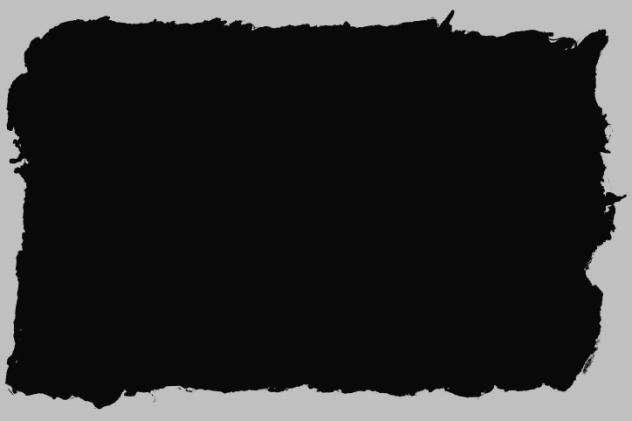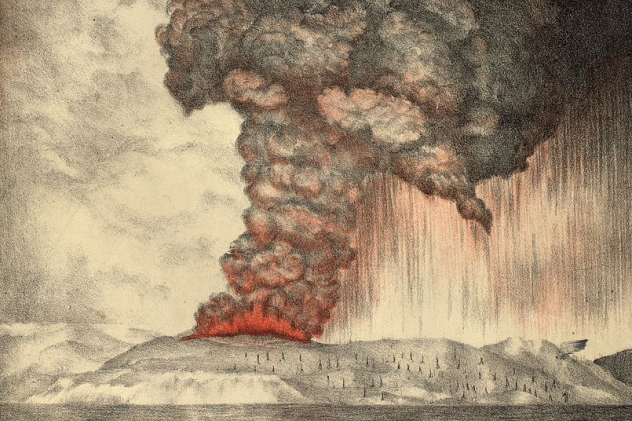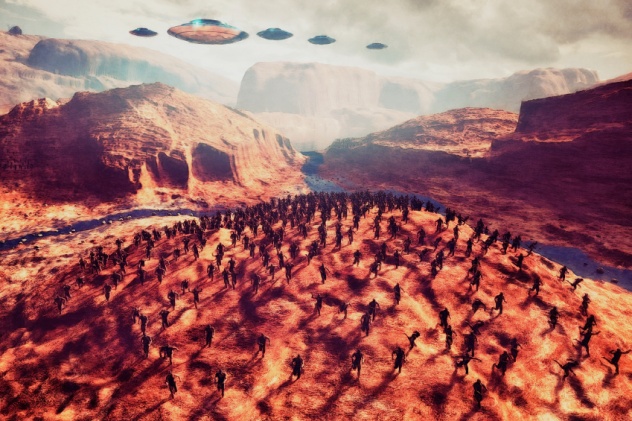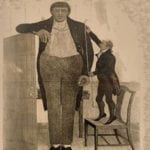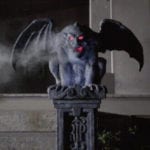10 The Marsh Paper
Charles Hoy Fort spent much of his adult life compiling some of the most bizarre phenomena that he could find records of while taunting the scientific community for their explanations and theories. The Book of the Damned was published in 1919, and in it, he explored phenomena like the marsh paper. According to his research, a group of workmen in the German city of Memel came across a mysterious mass lying on the frozen, snow-covered ground in 1686. Witnesses claimed that the mass, which was described as a flaky, damp, leafy, black substance that smelled vaguely like seaweed when wet, had fallen from the sky. When it was dried, the bad smell disappeared, and it became more fibrous, reminding them of paper. The explanation of the day was simply that it was some sort of plant matter that had been picked up in the recent snowstorm and dumped on the ground. The Royal Irish Academy claimed that they even knew what it was—a substance (albeit a rare one) that was known to form on the marshlands under certain circumstances. Fort was offended by the comparison and the attempt, as he put it, to simply claim the unknown substance is a known one rather than figure out what it was—even if the evidence doesn’t seem to line up. The Memel mystery marsh paper was black and leafy, while the Irish marshland substance was green and felt-like. It clearly wasn’t the same stuff, Fort concluded, in spite of some similarities under certain conditions. Later, Fort said, it was determined that the now-named “meteor-paper” was mostly of plant origin. He likens the findings to the idea that a peanut and a camel are the same thing, which is an obviously wrong conclusion that he says only happens when you’re just looking at the hump. He goes after the other explanation that it was clearly picked up and deposited by the wind or another storm by pointing out that there were no other mysterious appearances of things like fence posts. There are also records from 1686 of another mysterious substance, this one described as leaf-life and looking like burned paper, being identified as the black scale from meteorites. Fort didn’t say what he believes about the substance, aside from the fact that it was clearly misidentified. He wondered if there had been any otherworldly writing on the sheets to give further clues as to what it was, if only people had bothered to look.
9 Princess Caraboo
In 1817, an English girl named Mary Baker gained a certain amount of infamy by posing as a princess from the island of Caraboo. She spoke in a strange dialect and worshiped a strange god. Eventually, a Portuguese sailor appeared, claiming to be able to translate her strange language. It wasn’t long before Baker was recognized by a housekeeper who had seen her act before. Although this incident seems like a straightforward attempt by Baker to get people to think she was someone she clearly wasn’t, Fort had a completely different take on the idea. He recounted finding a slightly different story—that her language was finally translated by a mysterious “gentleman from the East Indies,” and that it was her mother (a Devonshire woman named Mrs. Willcocks, who appeared and identified her daughter) confessed to the ruse. He also pointed to a record that claimed she spoke in Malay, which was incorrectly identified by the mysterious “gentleman” who was translating her made-up language in an attempt to piggyback on her ruse. Regardless of the precise series of events, Fort said that it was a shame that she confessed, because he was fairly certain that there might have been something else going on. While she sadly might not be a visitor from Mars, the only explanation for her appearance—and her linguistic skills—is that she had been teleported to England from some exotic locale. Her confession, he said, was suspiciously complete while managing to leave out some major details, like the source of her language. Fort felt that the only explanation was that the confession was at least partially fictional and that Baker was one of a handful of mysterious individuals whose appearance could be explained by teleportation.
8 The Krakatoa Conspiracy
One of Fort’s ongoing theories was that mainstream science was simply making things up as it went, and it wasn’t above forcing a square peg into a round hole. That was the preferable approach, he claimed, and science was extremely good at looking in the other direction or clouding the facts to fit an accepted theory, rather than looking for the truth. In The Book of the Damned, Fort claimed that one major incident proved the scientific community was doing exactly that. The 1883 eruption of Krakatoa was followed by effects felt around the world, and the strangely colored skies weren’t just recorded in scientific journals and texts; they were also immortalized in paintings like The Scream. There were oddly colored sunsets and sunrises, unnatural-looking Moons and bizarre Suns, all created by the presence of dust and particles in the air from the eruption. Generally, it’s accepted that the autumn and winter months of 1883–1884 were the worst, and Fort cited that as a complete giveaway. He claimed that the scientific community used the eruption as a convenient excuse, blaming it for dust-filled skies well after the eruption had actually cleared. They even blamed it for phenomena seen in the skies before it happened. Strange skies were reported in Trinidad and South Africa before Krakatoa erupted, but it was easier to blame the eruption rather than to accept the truth—that the planet had been bombarded by something beyond our boundaries. Balls of marble-sized ash fell in Queenstown after the eruption. They, too, were wrongly attributed to the eruption. Fort also claimed that phenomena were being blamed on Krakatoa years after the eruption and after months of no strange skies or sightings, a clear sign that science was taking the easy way out. Nothing could stay in the atmosphere for that long, he said; it was clear insanity.
7 Copernicus Had It Backward
Fort’s writings were rambling, bizarre, and perhaps best described as the train-of-thought rantings of a possible madman. It’s hard to tell, sometimes, what he was putting forward as an honest idea, what conspiracy theories he really believed in, and what he was only pondering as a way to poke at what he perceived to be the holes in mainstream science. In New Lands, Fort took aim at what he saw as one of the most bogus of the scientific fields—astronomy. He was apparently incredibly offended by the wide acceptance of Copernicus’s explanation for the apparent movement of the stars and claimed that based on his observations, it’s just as possible that Copernicus got it completely backward. Fort used the example of a person on a boat. To someone on the shore, it’s clear that the boat is the part that’s moving and that they’re stationary. From the perspective of someone on the boat, though, it looks like the shore is moving and they’re stationary, even though that’s not the case. Copernicus, Fort said, went with the model of the Earth rotating because it was the simpler explanation and if it was the other way around, he would have been faced with a ton of other problems. There would have been the necessity of figuring out what it was that kept the stars moving, what kind of space substance filled the void and kept them the same distance apart, and what sort of reverse gravity was working on the extraterrestrial bodies to keep them consistently moving around a stationary Earth. Fort also said that not only are simplified explanations rarely the right ones, but that the widespread acceptance of Copernicus’s simple explanation laid the groundwork for us to get all subsequent theories about the cosmos and space absolutely wrong.
6 No Scientific Principle Has Been Proven
Reading Fort’s work is a bumpy, bizarre roller coaster ride, and you get the feeling that you’re definitely not going to end up where you started from. In his attempts to show that there are a lot of paranormal explanations out there as well as phenomena that haven’t been observed and cataloged yet, he argued that science itself is fundamentally flawed. He also said that no theories have ever been proven, that we actually exist in a pseudo-existence where everything is always changing, and that there’s room for whatever (and more than) you can imagine. He made several arguments that even the most widely accepted scientific facts haven’t been proven yet. Truth, he said, is universal, and because we can’t know anything beyond what we see and experience, we can’t know the truth. Fort used chemistry as his example of a science that can’t really be said to exist, because if circumstances, like the distance from the Earth to the Sun, were to change, chemistry would change, too, meaning it is not a universal constant. Our whole existence is relative to where and when we are. Fort took a shot at Newton, too. Newton’s three laws are some of the most basic principles of the scientific community, but Fort said that they’re really nothing more than “three articles of faith,” likening his principles to angels and demons, since inertia is just as mythological. Since Newton couldn’t isolate inertia as a separate force, and there was no way to know if there was another invisible and perhaps infinite force acting alongside it, there was no way to prove that it’s real. Fort said that there’s also no way to prove that a thing is an animal or a vegetable, because there’s no “positive test” to apply to a thing to determine that. Fort wrote, “As distinct from vegetables, animals do not exist. There is nothing to prove.”
5 The Connecting Forces
One of Fort’s theories was that everything that is and happens is connected by some force that we can’t always see. Fruits and vegetables, he argued, are connected by the tomato, in almost the same way that coincidences are connected—by something quite literal. In Wild Talents, Fort laid out a whole host of events that could be called coincidences. In 1894, several people died at a vineyard outside Fresno, California. In 1921, there were several instances of people losing consciousness in Zetel, Germany, with a similar thing happening in the Meuse Valley of Belgium in 1930. Three men who had gone to the Caspian Sea’s Sand Island on a hunting trip in 1909 had all died with no apparent reason, and in 1903, three hikers were found near the coal mine in Coalbridge, Scotland. Two were dead, and the third described something like a “shock.” Even stranger, he said, is April 10, 1893, when at least 12 Brooklyn men were taken to the hospital after either being hit by a falling object or falling themselves. On January 26, 1873, two fox-hunters were killed while on the hunt, and a few more mysterious hunting-related deaths followed shortly after. Then there was the April 30, 1911, incident where several English soldiers from Colchester were hospitalized with injuries that they couldn’t explain. Creepy and weird? Sure. Absolutely true? We’ll call that one a “possibly.” But Fort had a different theory, and that was the idea that the accounts he was compiling were connected by something paranormal, supernatural, and beyond our ability to see. All we could see was the common denominator, the thing that manifested this force that tied them all together. He used the fox-hunting scenario to specify what he meant. He wasn’t implying that there was a horse-tripping, neck-breaking monster out there, but fox-hunting has always been at odds with the farmers of the English countryside. Perhaps that collective hatred of the hunters and the damage they caused was enough.
4 The Mysterious Hair Clippings
Not all of Fort’s collected oddities led to the formation of a strange theory about invisible forces or conspiracies within the scientific community. Over the course of his scouring of the world’s newspapers, he compiled an unsettling number of claims regarding mysterious hair-cutting. Fort suspected that some of them were ordinary thefts, with the unseen assailant simply collecting hair to sell to hairdressers and wig-makers. Most of the victims were women, and while he first thought that this was a fetish that belonged in his group of freak collectors (which included collectors of ears), he soon determined that there was a financial motive behind most of them, and that others were false reports spurred on by mass delusions. The sheer amount of hair thefts that Fort recorded is unsettling, to say the least. There was the 1913 arrest of a Paris man who was found to have hair from 94 different women. Also worth mentioning is the Newark, New Jersey, incident of 1928, when an old man broke into a family’s home and cut the hair of all three of their young daughters. But, because this is Charles Hoy Fort, things take a turn to the paranormal. He cited the 1889 testimony of Dina McLean, who lived in Quebec with a family that had adopted her from an orphanage. She said that not only had someone pulled her braid and cut it off, leaving it hanging from only a few strands, but that there had also been a voice. The family called in an investigator named Percy Woodcock, and his conclusion had several parts. First, the family was feuding with the neighbors. Those neighbors had supposedly summoned a creature to pester Dina’s family, and when Woodcock confronted the spirit and called it out for its obscenity, it promptly repented, sang a little hymn, and was never heard from again. Fort suggested there are other cases of mysterious hair-cutting that were the work of poltergeists, including one incident that apparently happened at the home of a Wisconsin man who was living with his second wife (not long after the death of his first) as well as a rash of incidents in London.
3 Angels And Demons Are Aliens
Anyone who’s stumbled across Ancient Aliens while channel surfing has heard all about the theories that our planet was once colonized by beings from another world. It’s a weird piece of pseudo-history, full of supposedly unexplainable artifacts, impossible technologies, and mysterious messages, and Fort wrote about the idea in his 1923 book, New Lands. On October 3, 1843, a group of farmers and laborers saw something bizarre in the skies over Warwick. Testimony from a handful of people who’d been in the area was much the same. There had been a cloud in the sky, and suspended beneath the cloud, as though they were hanging from belts, were three angels. The angels were fairly low, just above the trees, and they floated along as the cloud wafted across the sky. And they moaned. It was described as a “loud and mournful noise.” The angels didn’t seem to move on their own but rather were pulled along by the cloud, which Fort said was probably not the image of eternal salvation that your Sunday school teacher would want you to hear about. He went on to say that he didn’t think that the incident was a case of a mass delusion or workers’ eyes playing tricks on them. He said he was pretty sure that all reported appearances of both angels and demons aren’t a manifestation of any spiritual beings or psychic phenomena but rather very real visitors from outer space. No matter who’s reporting them, he said, whether it’s a priest, a weatherman, or an astronomer who sees the figures and shapes in the sky, we’ll find out one day that they’re space travelers.
2 Sky Continents
While it’s generally accepted that continents are found on the surface of a planet, Fort argued that there was a chance that there were some up in the sky, too. One of the signs that there’s something up above us, he claimed, was the auroras that sometimes lit up the night. Fort said we’re told to believe that auroras are generated by the interaction between electricity and Earth’s poles, an explanation which he said makes no sense whatsoever. If that was the case, then the so-called Northern Lights wouldn’t be recorded in Pennsylvania when they weren’t seen anywhere else to the north, and the classification of a light in the sky as an aurora is clearly ignoring the obvious. There are lands in the sky above us, not far away, and if people would open their minds to the idea that Earth isn’t alone, they’d get past that self-centered notion and realize that we could align ourselves with these higher forces and prosper. Fort also recorded other phenomena that he claimed as evidence that there are continents in the sky above us. There had been years of strange lightning and sounds above Comrie, Scotland. He also pointed to apparent explosions heard over Barisal, Bengal, in 1874 and a series of sounds that seemed to be cannon fire over Tunis in 1881. There were also the many reports of what sounded like the fire of heavy guns over Cambridgeshire and Essex in January 1869. And in 1883, the steamship Resolute was in the Arctic Ocean, presumably miles from everything, when its crew recorded what sounded like gunfire in the skies overhead. According to Fort, it’s only logical that meteors and other objects fall from the sky if they’re falling off massive sky continents. He said that he thought he even knew where one of the continents was, citing the unusual amount of activity he found taking place over a triangular patch of England between Worcester, Reading and Berkshire, and Colchester in Essex. He called it the “London Triangle.”
1 Ancient Aliens And The Blue Britons
Fort published The Book of the Damned in 1919, and when he did, he became the first person to publicly ponder the idea that we had been colonized, bred, and shaped by ancient alien visitors. Fort was trying to answer the question of why, if there’s life out there in space, we haven’t been contacted. His answer was twofold: We have been, and the civilization that’s made contact with us is warning everyone else to stay away. Fort envisioned a past where the surface of the planet was a battlefield between warring alien races, and with the emergence of a victor came a clear message to everyone else: Keep your little green hands off. That’s just part of it. What Fort could only speculate about was why the planet was so valuable to these alien creatures. He suggested that we’re useful to them somehow, although whether we’re a source of slaves or resources, he wasn’t sure. We may have been populating harems, mining or farming resources for a race that couldn’t tolerate the conditions on our planet, or we may have been used as a trading outpost. We might have been a colony on the fringes of the known galaxy. Whatever we were, Fort was fairly certain that we hadn’t been visited and settled by only one race, and he was pretty sure that a whole bunch of alien races have influenced the growth and development of life on Earth. Fort admitted to not being very sure about much, but he did think that the group of aliens that settled in what’s now Britain and in the areas ruled by the ancient Celts were blue. “Conventional anthropologists” claim that the Celts only painted their skin blue, but the discovery of what seems to be a minor footnote in history—the birth of a child with blue skin—cemented his theory that the ancient aliens of England were blue. Fort even had a story to go along with the theory. The “blue Britons” came from Azuria and initially landed on Earth as missionaries. They tried to turn the people they found on Earth blue, but the Earthlings refused and gained the ire of Azuria. Since they all wouldn’t become blue, she (or they) unleashed their holy wrath on them and their fortifications, striking the stone buildings with alien lightning. You can still find evidence of the battles today, in the vitrified forts that dot the countrysides of only Britain, Ireland, Bohemia, and Brittany. Read More: Twitter
